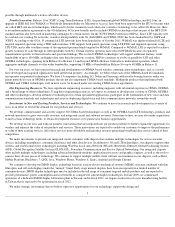Qualcomm 2011 Annual Report Download - page 20
Download and view the complete annual report
Please find page 20 of the 2011 Qualcomm annual report below. You can navigate through the pages in the report by either clicking on the pages listed below, or by using the keyword search tool below to find specific information within the annual report.
commercialize Windows 8 on ARM processor-equipped devices;
Companies that promote WWAN (Wireless Wide Area Network) technologies that are neither CDMA- nor OFDMA-based (e.g., GSM) and
companies that design integrated circuits based on CDMA, OFDMA or their derivatives are generally competitors or potential competitors.
Examples (some of whom are strategic partners of ours in other areas) include Broadcom, CSR plc, Freescale, Fujitsu, Intel, Lantiq, Marvell
Technology, Mediatek, nVidia, Renesas Electronics, Spreadtrum Communications, ST-Ericsson (a joint venture between Ericsson Mobile
Platforms and ST-NXP Wireless), Texas Instruments and VIA Telecom. Many of these current and potential competitors have advantages over
us that include, among others: motivation by our customers in certain circumstances to find alternate suppliers; foreign government support of
other technologies; and more extensive relationships with indigenous distribution and original equipment manufacturer companies in developing
territories (e.g., China).
Certain of our and our suppliers’ software may contain or may be derived from “open source” software, and we have seen, and believe we
will continue to see, an increase in customers requesting that we develop products, including software associated with our chipsets, that will
incorporate open source software elements and operate in an open source environment, which, under certain open source licenses, may offer
accessibility to a portion of a product’s source code and may expose related intellectual property to adverse licensing conditions. Licensing of
such software may impose certain obligations on us if we were to distribute derivative works of the open source software. For example, these
obligations may require us to make source code for the derivative works available to our customers in a manner that allows them to make such
source code available to their customers, or license such derivative works under a particular type of license that is different than what we
customarily use to license our software. Developing open source products, while adequately protecting the intellectual property rights upon
which our licensing business depends, may prove burdensome and time-consuming under certain circumstances, thereby placing us at a
competitive disadvantage for new product designs. Also, our use and our customers’ use of open source software may subject our products and
our customers’ products to governmental scrutiny and delays in product certification, which could cause customers to view our products as less
desirable than our competitors’ products. While we believe we have taken appropriate steps and employed adequate controls to protect our
intellectual property rights, our use of open source software presents risks that could have an adverse effect on these rights and on our business.
Competition may reduce average selling prices for our chipset products and the products of our customers and licensees. Reductions in the
average selling prices of our licensees’
products, unless offset by an increase in volumes, generally result in reduced total royalties payable to us.
We anticipate that additional competitors will introduce products as a result of growth opportunities in wireless communications, the trend
toward global expansion by foreign and domestic competitors, technological and public policy changes and relatively low barriers to entry in
selected segments of the industry.
We derive a significant portion of our consolidated revenues from a small number of customers and licensees. If revenues derived from these
customers or licensees decrease, our operating results could be negatively affected.
Our QCT segment derives a significant portion of revenues from a small number of customers. The loss of any one of our QCT segment’s
significant customers or the delay, even if only temporary, or cancellation of significant orders from any of these customers would reduce our
revenues in the period of the delay or cancellation and harm our ability to achieve or sustain expected operating results. Accordingly, unless and
until our QCT segment diversifies and expands its customer base, our future success will largely depend upon the timing and size of any future
purchase orders from these customers.
Although we have more than 200 licensees, our QTL segment derives a significant portion of licensing revenues from a limited number of
licensees. Our future success depends upon the ability of our licensees to develop, introduce and deliver high-volume products that achieve and
sustain customer acceptance. We have little or no control over the sales efforts of our licensees, and our licensees might not be successful.
Reductions in the average selling price of wireless devices sold by our major licensees, without a sufficient increase in the volumes of such
devices sold, could have an adverse effect on our revenues.
Efforts by some communications equipment manufacturers or their customers to avoid paying fair and reasonable royalties for the use of
our intellectual property may create uncertainty about our future business prospects, may require the investment of substantial management
time and financial resources, and may result in legal decisions and/or actions by foreign governments, Standards Development
Organizations (SDOs) or other industry groups that harm our business.
A small number of companies, in the past, have initiated various strategies in an attempt to renegotiate, mitigate and/or
15
• focus our service businesses on key opportunities, such as eHealth and machine-to-machine technologies (allowing both wireless and
wired systems to communicate with other devices), among others, that create standalone value and/or contribute to the success of our
other businesses;
• be a leader in the 4G technology evolution, including expansion of our LTE (and WiMAX) single mode licensing program and timely
introduction of 4G turnkey, integrated products and services; and
• succeed in significant foreign regions, such as China, India and Europe.
























